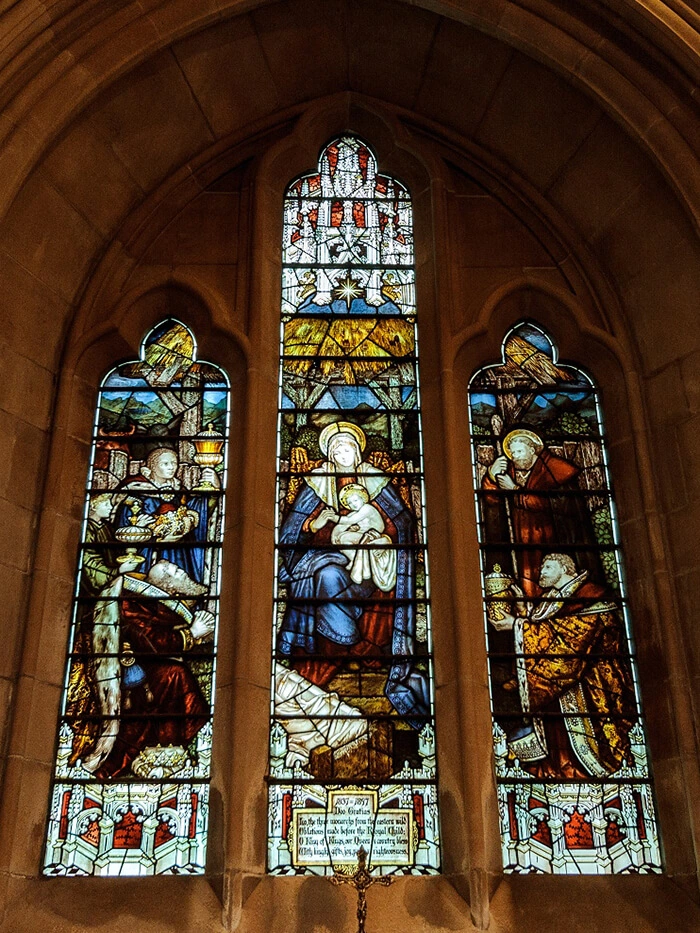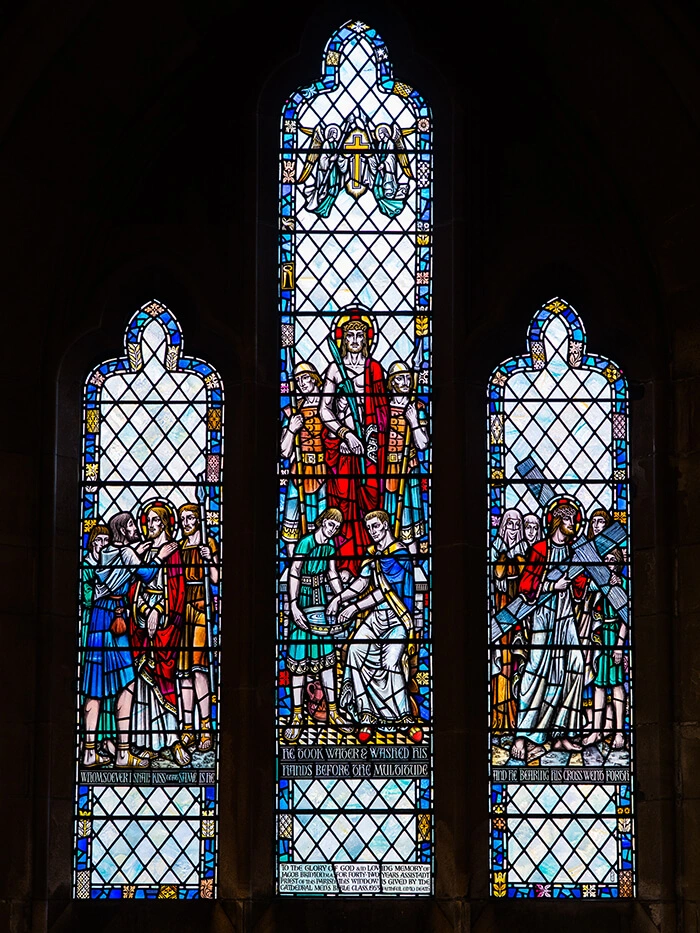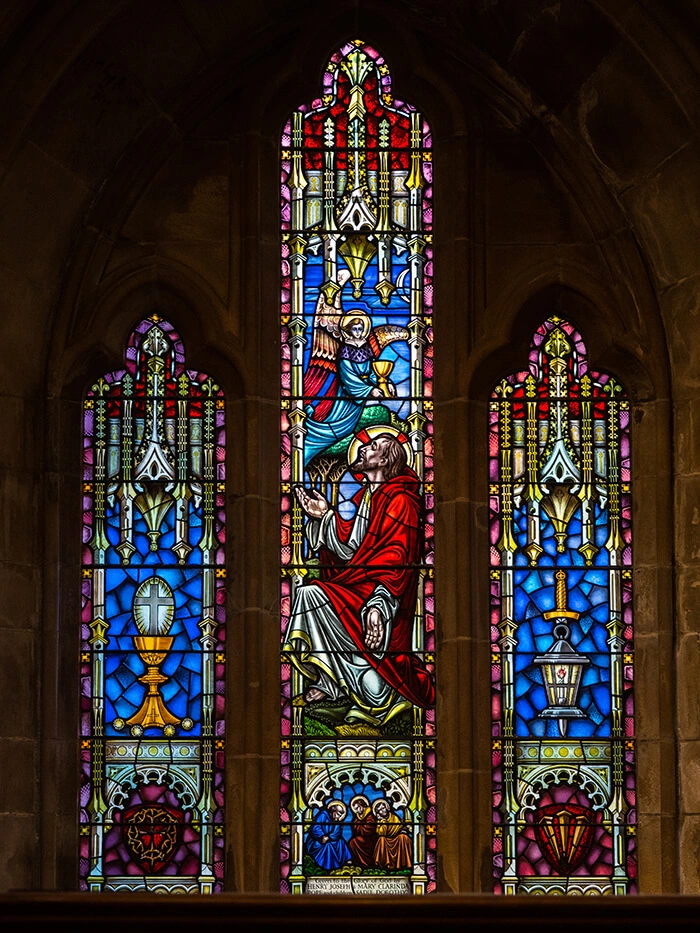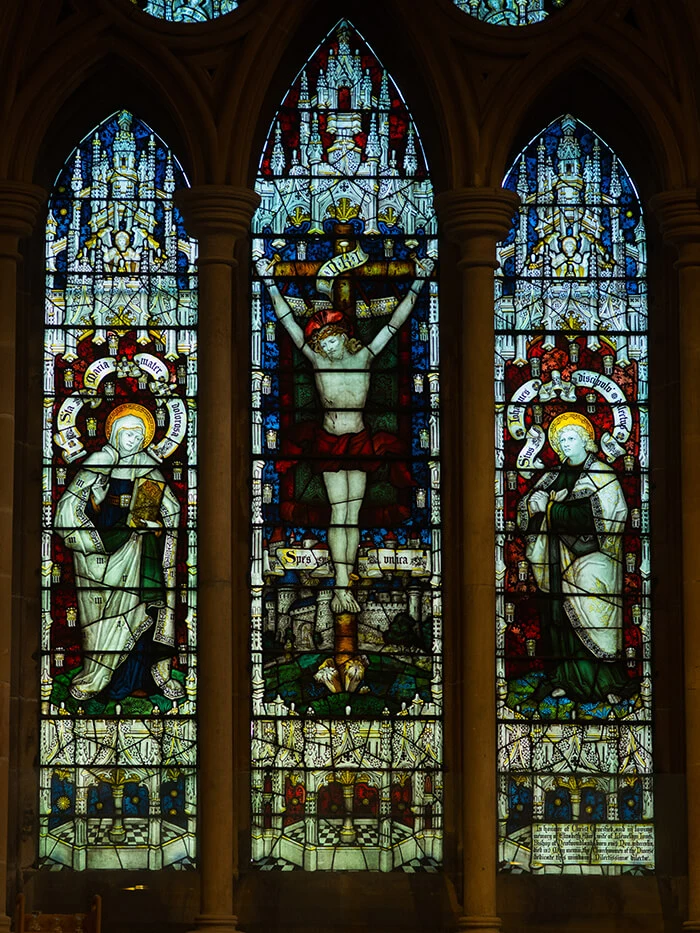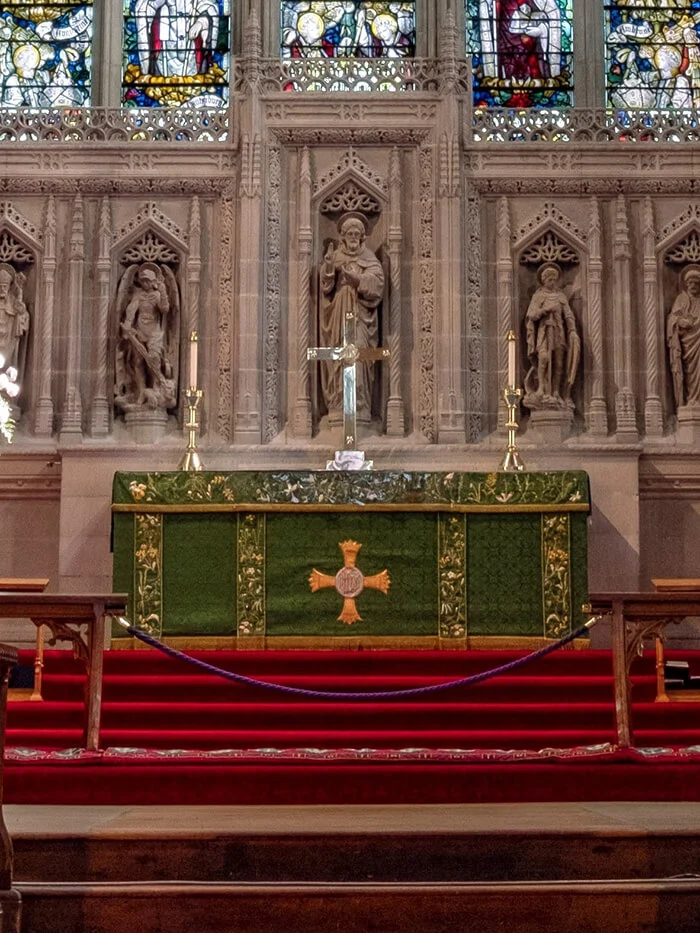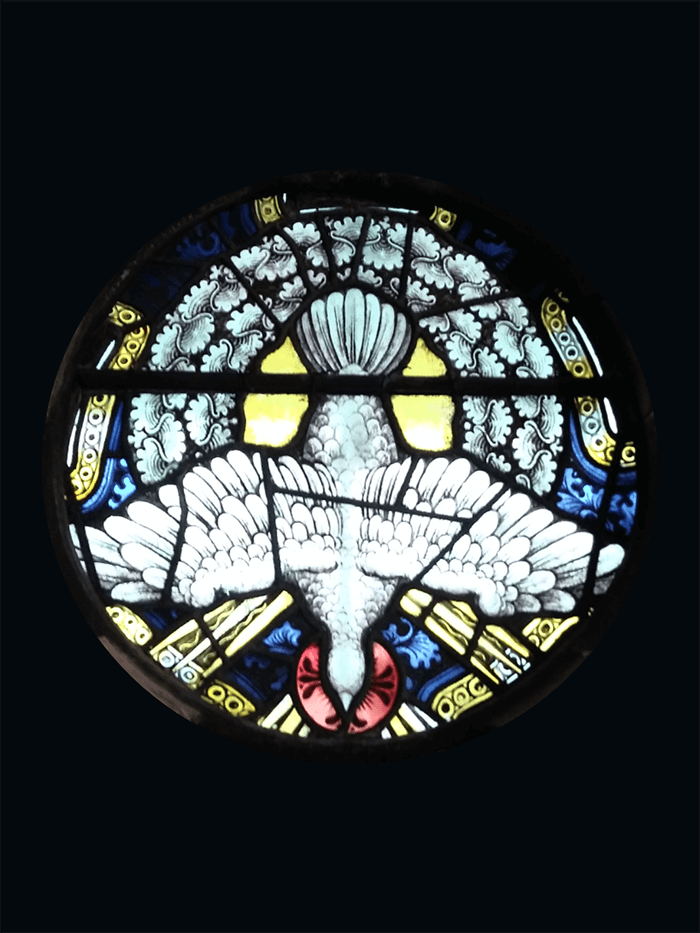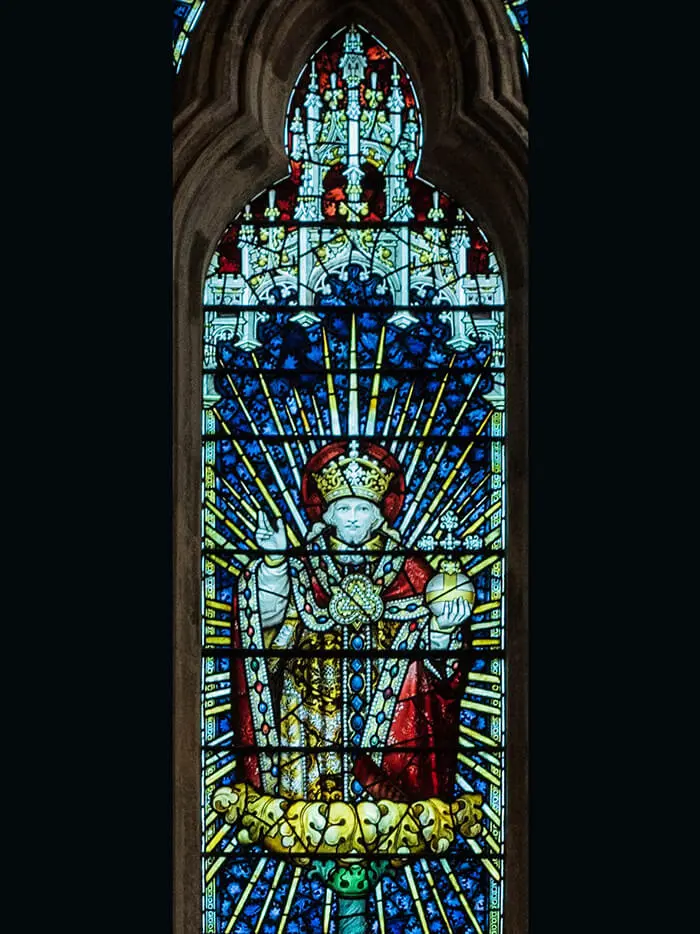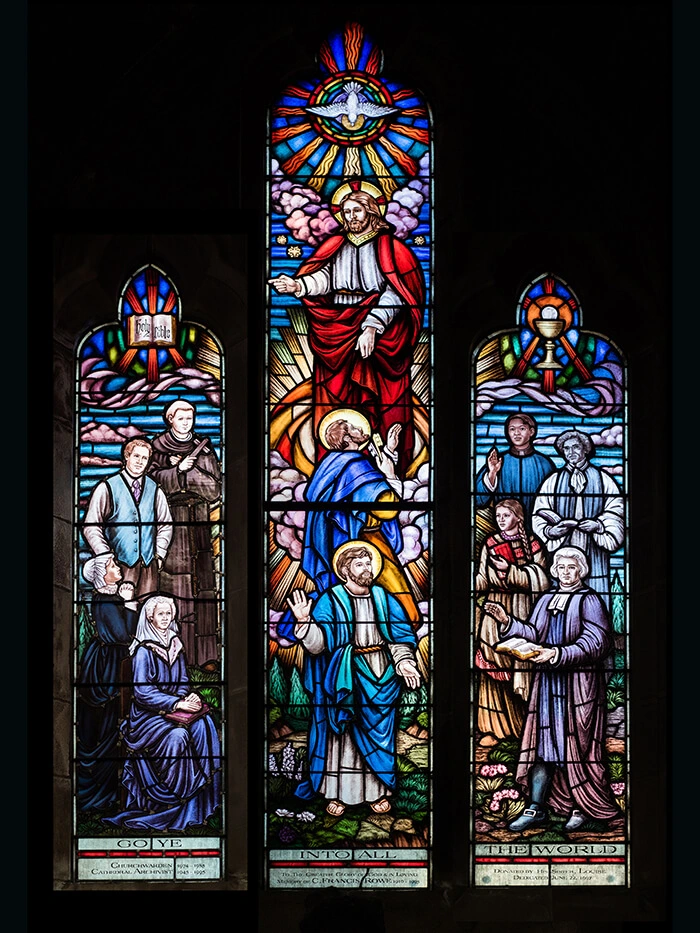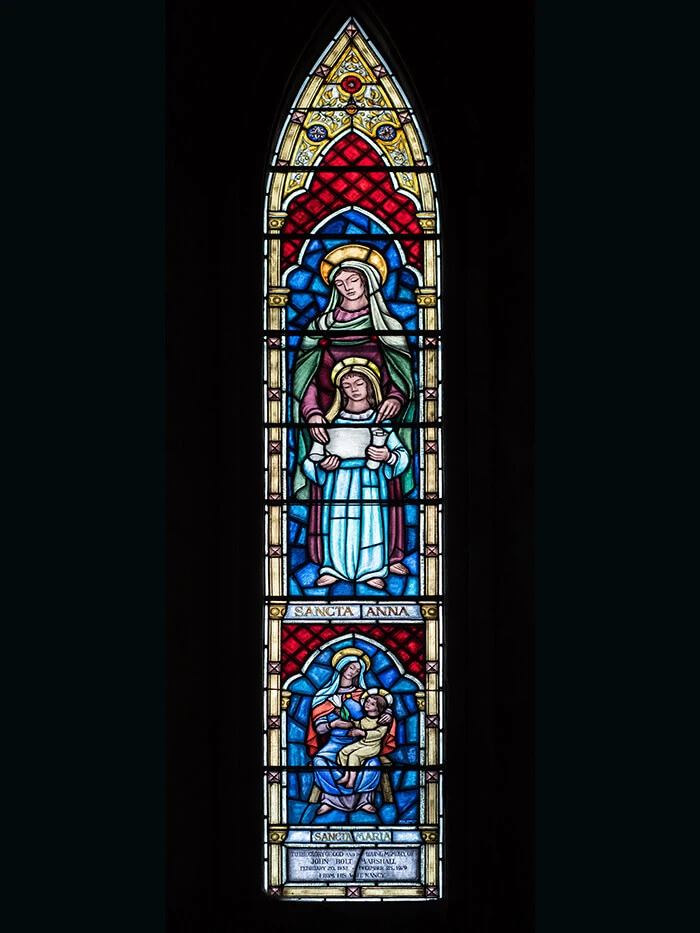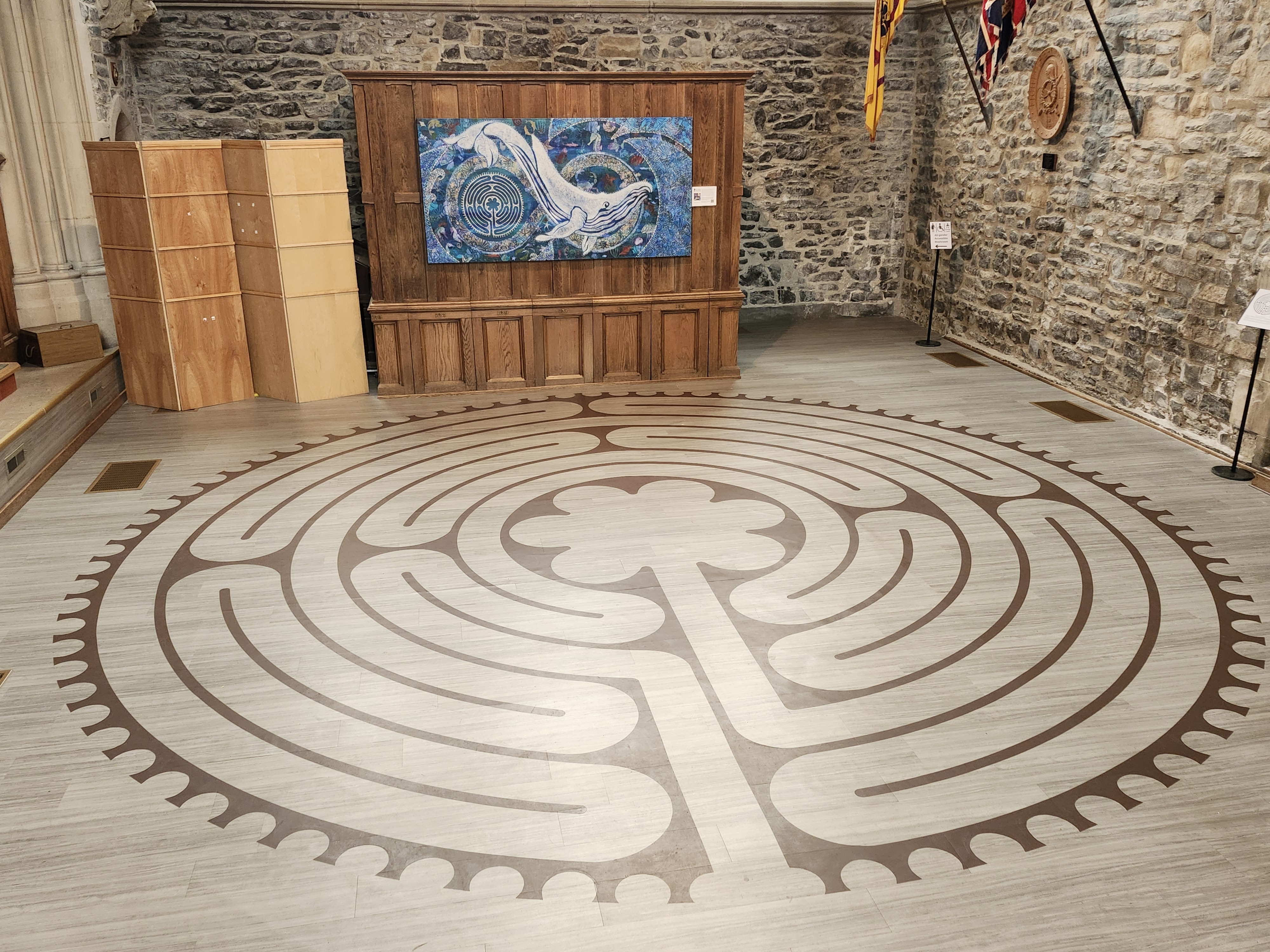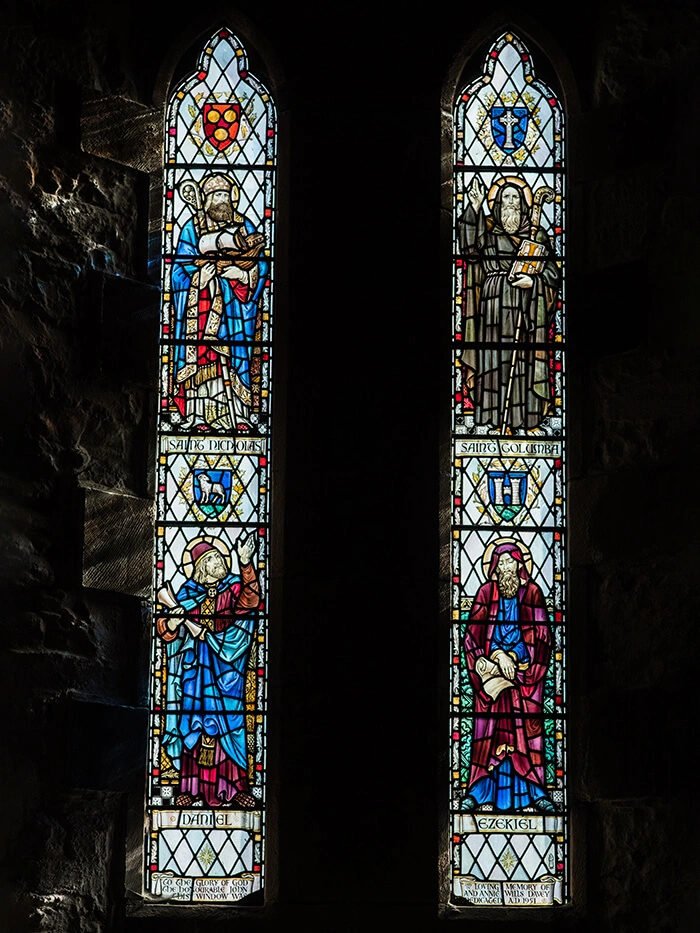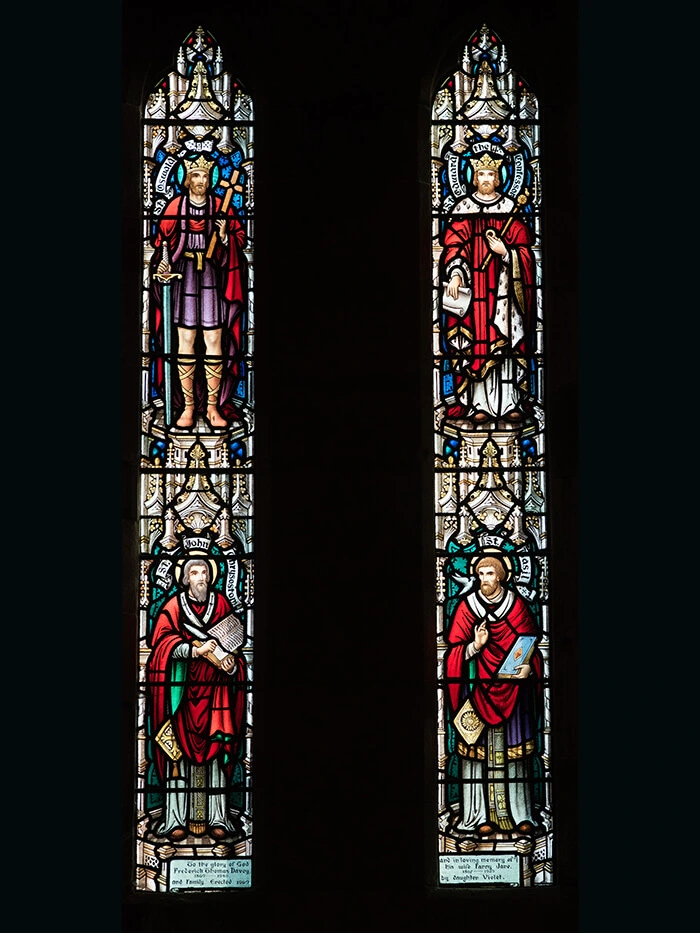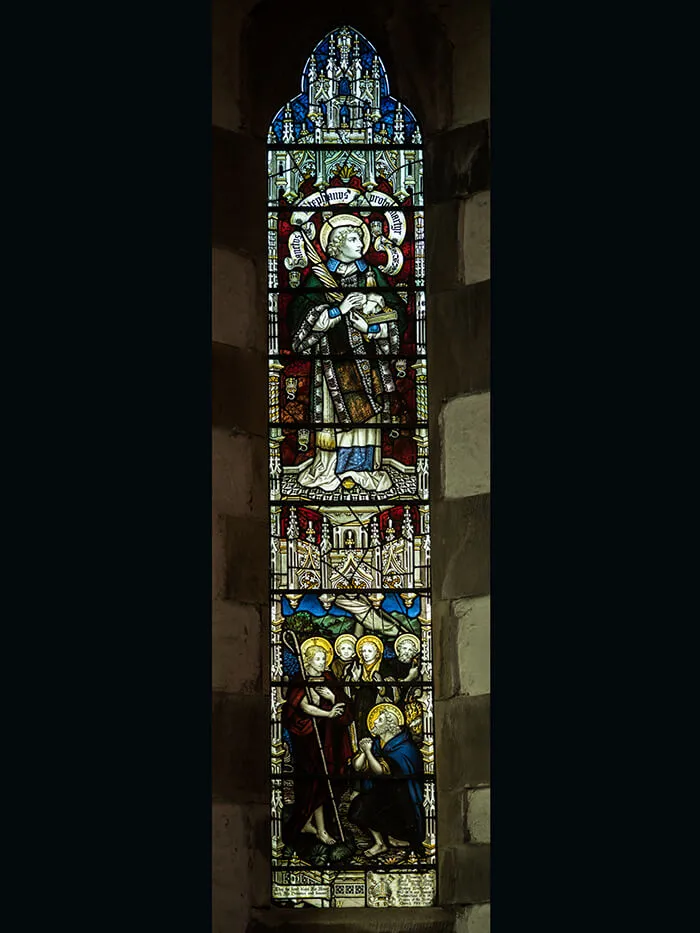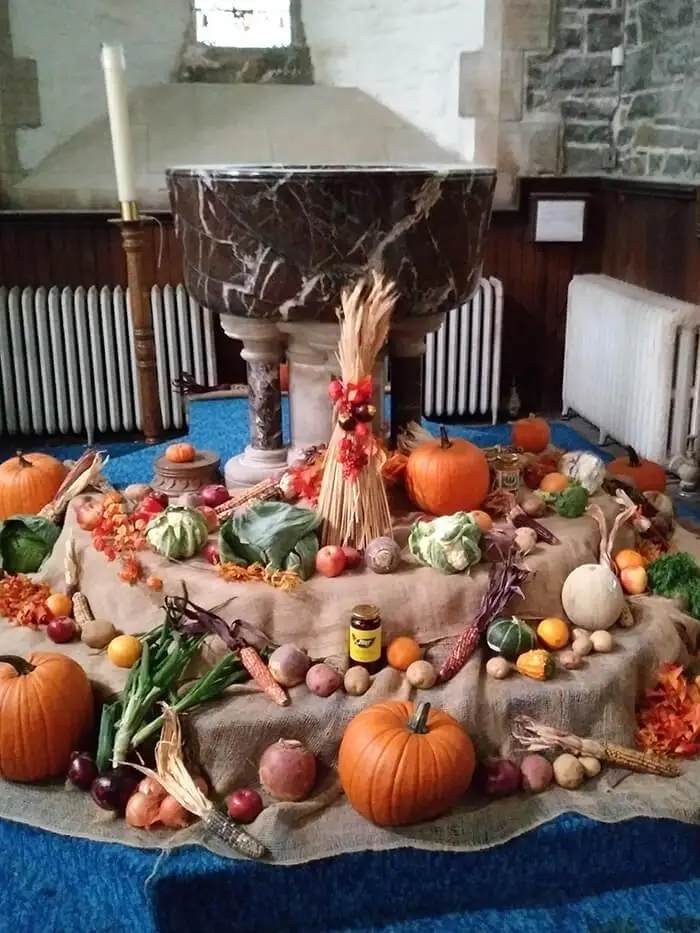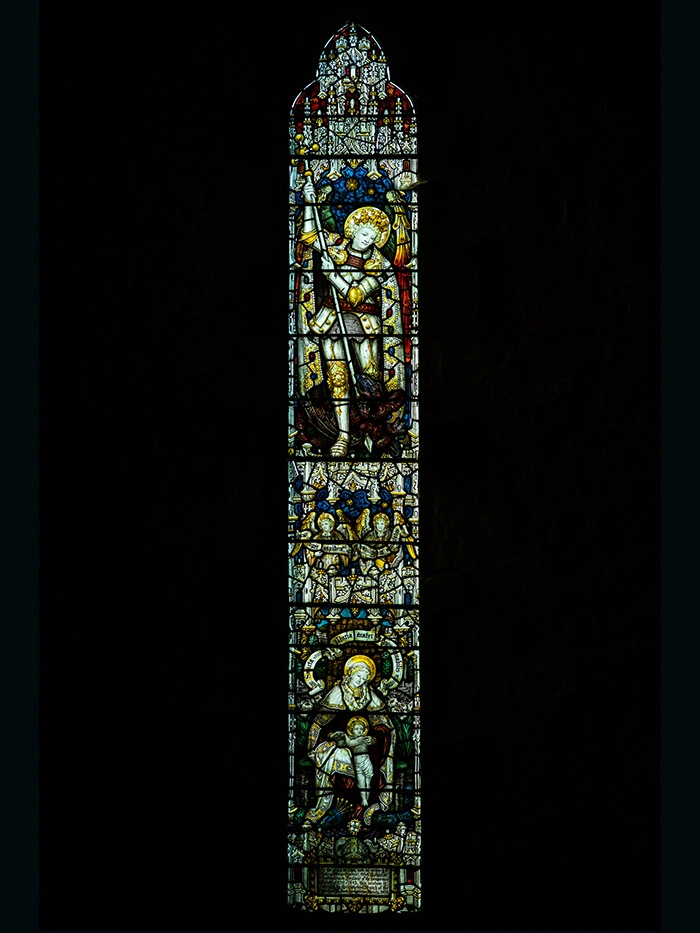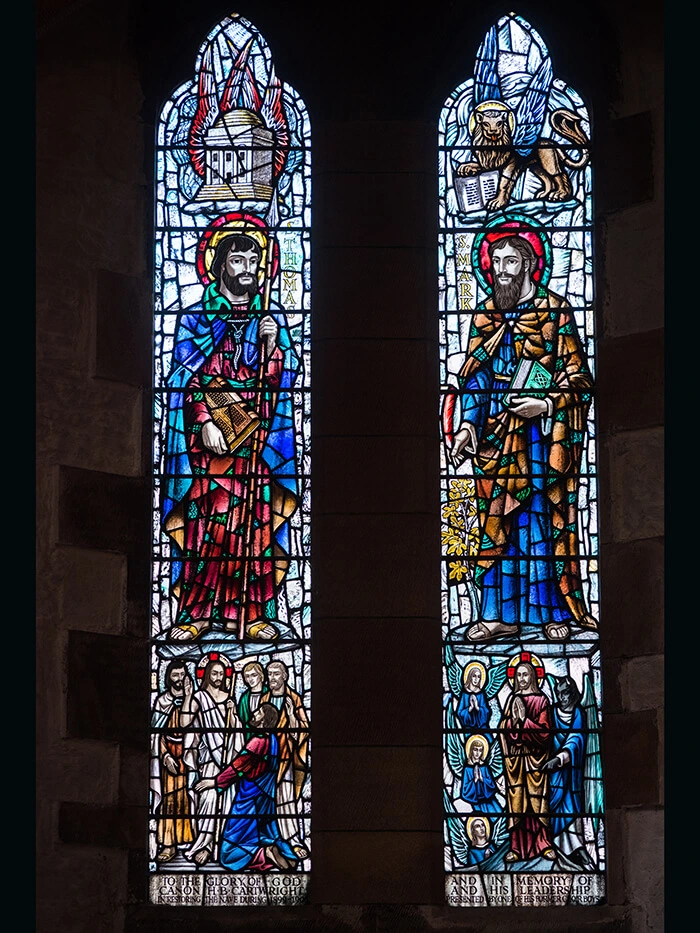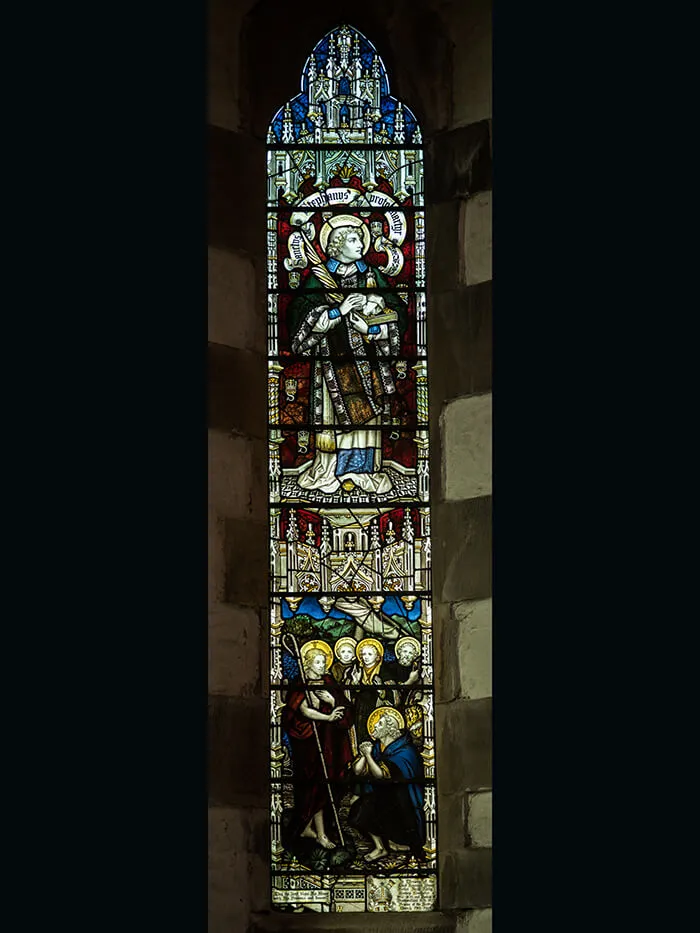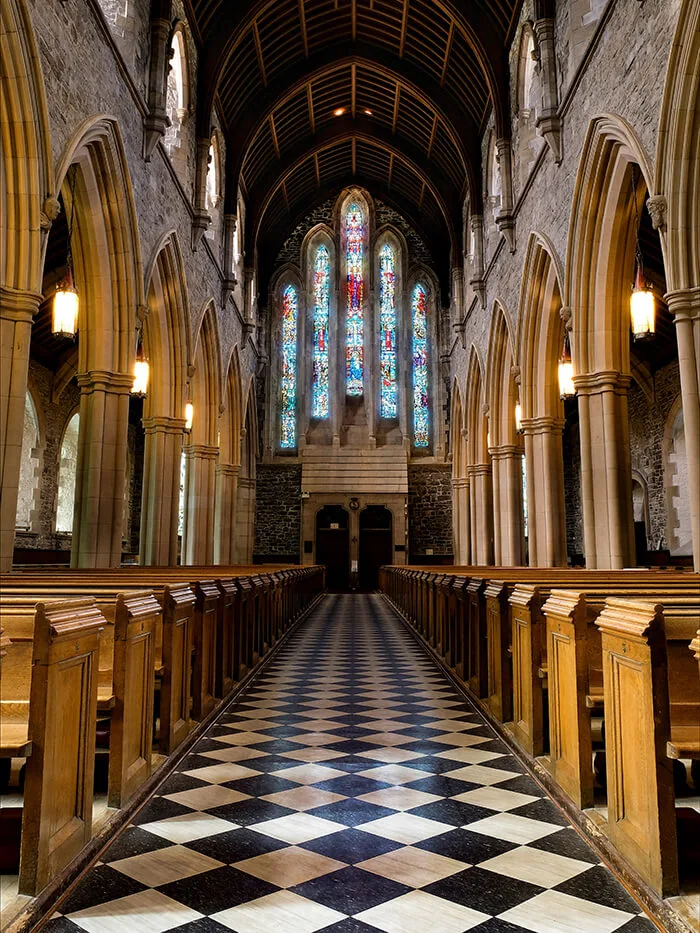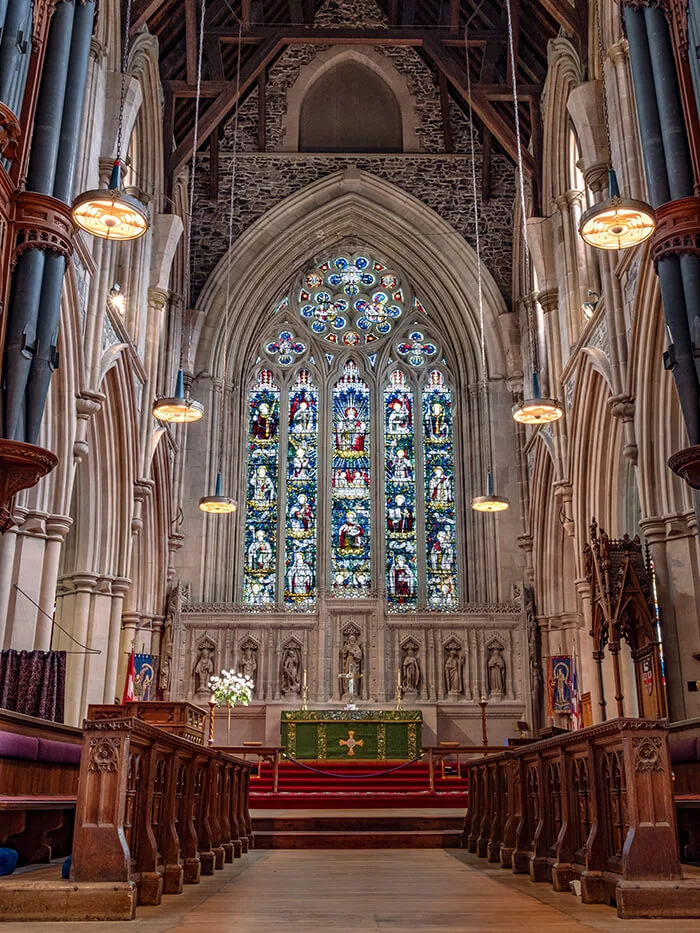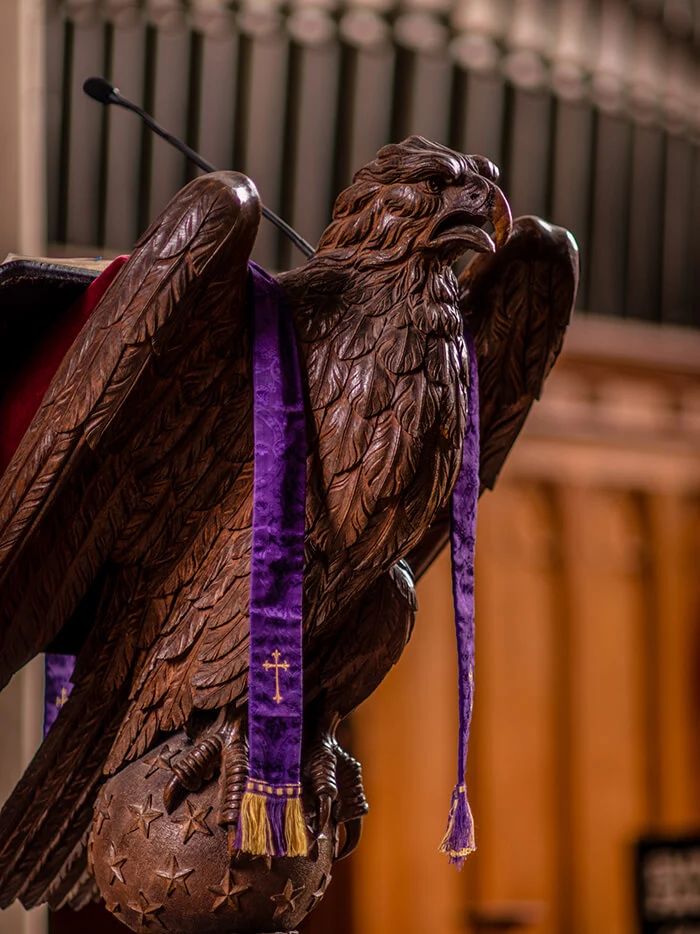This Tour is useful if you are walking through the Cathedral,
or visiting from your own home!
THE LIBRARY
THE LADY CHAPEL
THE SANCTUARY & CHANCEL
THE SACRISTY
THE MUSEUM
THE SOUTH TRANSEPT
THE SOUTH NAVE & AISLE
THE WEST WINDOW & BAPTISTRY
THE NORTH NAVE
THE NORTH TRANSEPT
MORE POINTS OF INTEREST
THE LIBRARY
THE LIBRARY
Our Tour of the Cathedral starts in The Library, on the left (or North) side of the Chancel.
The Cathedral Library was opened as a Library in 1972, after the renovation and refurbishing of this area along with the Lady Chapel. Its two windows are inspired by paintings of the Renaissance. The first (1898) depicts the Annunciation, with Gabriel and the Virgin Mary, the second (1898) the Adoration of the Magi, or Worship of the Three Kings (donated as a memorial of Queen Victoria's Diamond Jubilee). Made by C.E. Kempe of London, these windows were the first to be installed after the Great Fire of 1892. The Kempe firm is also responsible for 14 other windows in the Cathedral, all highly detailed and containing no colourless glass; even glass that appears to be white is actually treated with silver nitrate. The firm's trademark, a small golden wheat sheaf (after Kempe's death in 1907, a tower was added), can be seen in the lower left-hand margins of many of these windows.
THE LADY CHAPEL
THE LADY CHAPEL
Beyond the Library lies the Lady Chapel. Dedicated to Our Lady, the Blessed Virgin Mary, this chapel underwent extensive reconstruction in 1972 under the sponsorship of the Girl's Friendly Society and the Cathedral Men's Bible Class, when the concrete ceiling was installed. A special feature of Gothic architecture, rib vaulting channels the weight of the roof and ceiling efficiently into the piers and walls, thus enabling larger window openings without endangering the roof's stability.
Just before you enter the Chapel from the Library, displayed in a wall case on the right is the work of the two Browser (or Bowsor) sisters: the splendid gold-embroidered Altar Frontal, now used only on the greatest feast days. Above the Browser Frontal are Coats-of-Arms which were carved by Mr. James Crawford, a former Churchwarden. These represent the Archbishops and Bishops who presided at the consecration of the first five Bishops of Newfoundland, namely A.G. Spencer, E. Feild, J.B.K. Kelly, L. Jones, and W.C. White, whose Coats-of-Arms are at the bottom of each set.
The needlepoint kneelers and chair cushions, in the blue traditional for the Blessed Virgin, are owed to the labour and kindness of the Cathedral Altar Guild in 1975; each piece is dated and signed on the back by its maker.
To the left of the altar, which was given in memory of Bishop White, stands a banner of St. John the Baptist.
The Chapel's predominantly yellow and green-toned main windows, representing Ecce Homo (Behold the Man) (1907) and Our Lady and St. John at the Foot of the Cross (1904) are also by C.E. Kempe. The remaining windows on the north side, depicting the Agony in Gethsemane (1972, Wippell Mowbray, Exeter) and Pilate and the Judgement Hall (1953), are of more recent date, showing more modern tastes in representation. The Pilate window was executed by James Powell & Sons (Whitefriars), a firm also responsible for four other windows in the Cathedral. Its handiwork is distinguished by the trademark figure of a small white hooded monk, usually in the lower right-hand part of each window.
The Lady Chapel is normally used for private prayer and occasionally for services with few people.
THE SANCTUARY & CHANCEL
THE SANCTUARY & CHANCEL
Turning right and continuing into the Chancel, you see the High Altar on the east wall (to the left). Beautifully carved English brown oak forms the Altar's base, while the top, a single three-inch thick slab measuring nine feet by three, is red Belgian marble quarried in the Ardennes.
The Reredos behind the Altar was placed in the Cathedral in 1923 by the family of Llewellyn Jones, 4th Bishop (1878- 1917). Carved from two kinds of freestone, it was designed by Giles Gilbert Scott, grandson of Sir George Gilbert Scott, the Cathedral's original architect. This screen includes eleven pieces of statuary, with Christ in the centre and two angels at each end. On the left side (from left to right), stand St. Theodore of Tarsus, Archbishop of Canterbury 668-690; St. David ( 540), patron saint of Wales; and St. Michael the Archangel overcoming Satan. Continuing on the right side (from left to right) stand St. George, patron saint of England; St. Andrew, patron saint of Scotland; and St. Patrick, Ireland's patron saint, holding a shamrock.
Above the Reredos is the East Window (1911), "The Tree of the Church," which is comprised of five lancets and five rose windows. In the uppermost rose is the Holy Spirit, represented as a dove. The central lancet depicts Christ the King, with St. John the Baptist below him. On either side, in the upper portions of the two adjoining lancets, are four angels who surround the image of Christ the King. Below them on the right are St. Paul with a sword and St. Aidan, an early Celtic missionary, holding his abbey of Lindisfarne. The lancet on the extreme right contains the martyr St. Cyprian of Carthage (oddly labelled "Cyril"), St. Athanasius of Alexandria, a Doctor of the Eastern Church, and St. Ambrose of Milan, a Doctor of the Western Church. Beneath the angels on the left are St. Peter, holding the keys of the Kingdom, and St. Augustine, the first Archbishop of Canterbury. On the extreme left are the early martyr St. Ignatius of Antioch, with the chains of his imprisonment, St. John Chrysostom, another Doctor of the Eastern Church, and St. Augustine of Hippo, a convert to Christianity and the Western Church's greatest Doctor.
The Kneeler at the Altar Rail is the handiwork of the ladies of the C.E.W.A. (Church of England Women's Association) in the 1930's. Other kneelers and chair cushions in the Sanctuary, along with those belonging to the Canons' Stalls in the Chancel, are the work of the Cathedral Altar Guild during the 1970's and 1980's. On the right side of the Chancel stands the ornately carved Bishop's Throne. Its Latin name is 'cathedra,' giving us the word "cathedral," which means the building where a Bishop has his seat. The gables of its canopy are decorated with oak leaves; on the front are small figures of St. John the Baptist, the Cathedral's namesake, and St. Augustine of Canterbury, with Christ crucified between them. The Bishop's Throne, as well as all other woodwork in the Chancel and the Eagle Lectern, was designed by Gilbert Scott and executed in oak by Harry Hems of Exeter.
On the left of the Chancel is the console for the Organ by Casavant Frères of St. Hyacinthe, Quebec (installed 1927); the case is a Carnegie benefaction. There are about 3,500 pipes controlled by four manuals (keyboards), a pedal board, and 56 stops. The dark pipes on either side of the chancel were part of the earlier English (Hope-Jones) organ of 1904. Herald angels grace the ornate casing.
The large ornately carved chair opposire the organ console is the Bishop's Throne, known as a 'Cathedra,' which gives the building its title as 'Cathedral.'
THE SACRISTY
THE SACRISTY
On the left, past the Bishop's Throne, is the Sacristy (where the priests prepare for worship). The Ascension Window (1987), the work of the Robert McCausland Studios (Toronto) and one of the newest windows in the Cathedral, was given by Francis Rowe and Louise Lambiase in memory of their brother Edward L. Rowe, who was for many years the Cathedral Sacristan. Adjacent to it is the Cathedral's oldest window, the tripartite Resurrection Window (1886) by Lavers, Barraud, and Westlake, which is the only stained glass to survive the fire of 1892. The "tears" visible on Mary's face are molten lead, a direct result of the fire's intense heat; lead has also run down the centre of Christ's face. One quatrefoil above the main window contains the scrambled word "PAX," indicating that it was installed backwards and upsidedown.
Just beyond the Sacristy, on the right above the stairs, is the Victoria Window (1903), given "by an Englishwoman" in memory of Queen Victoria. The Queen is depicted in prayer opposite the English king Alfred of Wessex. Above Victoria is King Ethelbert of Kent, whom St. Augustine converted to Christianity in the early seventh century, for the re-conversion of Britain begins with the advent of Augustine of Canterbury. Saints Peter and Paul are in the centre, and above all is enthroned Christ the King.
THE MUSEUM
THE MUSEUM
The Cathedral Museum is on your left as you go through the passageway leading to the south transept. It holds such items as the letter of petition (copy on display) that was sent to the Bishop of London in 1699, the key to the 1850 Cathedral, and photographs recording the damage the Cathedral suffered in the fire of 1892. The Museum tells the story of the Parish from its foundation in 1699.
The Museum also contains stained glass: two windows and a commemorative medallion. The smaller window, installed in 1981, was given in memory of John Bolt Marshall (1981). Designed by Theo Lubbers Studios, Montreal, it depicts three generations of the Holy Family: St. Anne with her daughter Mary, and Mary with her son Jesus. On the left (1997) is the Cathedral's newest window, illustrating Christ's Great Commission, "Go ye forth into all the world..."; other figures include St. Peter and the Rev. John Jackson, first incumbent of the parish. Executed by Robert McCausland of Toronto, it was given by Louise Lambiase in memory of her brother C. Francis Rowe (1916-1995). Above the transept screen hangs the medallion (made by Powell/Whitefriars), presented to the Cathedral in 1933 by the Society for the Propagation of the Gospel as a memorial of the SPG's centuries of support. Also found in the Museum are a number of sculpted heads from the first stone ediface of the Cathedral.
THE SOUTH TRANSEPT
THE SOUTH TRANSEPT
Just outside the Museum, and to the right, the Canterbury Cross is attached to the southeast pier of the transept crossing, next to the Eagle Lectern. It is modelled on a brooch unearthed during excavations in 1860 at a site in Canterbury where churches have stood since the sixth century. That original brooch, which has come to be known as the Canterbury Cross, was Saxon in design, probably from the eighth century, and fashioned with arms of equal length hammered into an almost complete circle. Around 1932, reproductions of this cross, including the original's vine-leaf detailing, were made and affixed to pieces of stone from Canterbury Cathedral, then presented to each of the Cathedral Churches of the Anglican Communion throughout the world as a visible representation of communion with Canterbury. Other examples of this cross can be found at Canterbury Cathedral, together with the names of the dioceses so honoured.
The Gargoyle above the door in the left (south-east) corner of the South Transept was donated by the Diocese of Bristol, England, in 1967. Bristol was the port from which John Cabot set sail in 1497 on his voyage of discovery. This gargoyle was formerly on a tower of St. Augustine's Cathedral, Bristol.
The South Transept features a Labyrith which was installed in 2024. To find out more please visit our Labyrinth Page.
THE SOUTH NAVE & AISLE
THE SOUTH NAVE & AISLE
On the Southwest Pier of the transept crossing is found a bronze plaque commemorating the Rev. Edward Carrington of Devon, England, who was Rector of the Cathedral from 1819 to 1839. The chancel (east) side of this pillar also bears a tablet recording the names of the men from this Parish who gave their lives in the First World War (1914-1918).
Proceeding westward along the South Aisle, you will see six windows with double lancets topped by quatrefoils; all but the fifth commemorate deceased members of the Davey family.
The first window (1909) shows the theologian-saints Jerome and Anselm and the Old Testament patriarchs Noah and Moses.
The second window (1913) depicts the holy bishops Paulinus and Aidan, early missionaries to the English, and the patriarchs Joshua and Abraham (with Isaac).
The third (1933) commemorates the prophets Isaiah and King David, together with the martyr saints Lawrence and Alban. The fourth of the Davey memorial series (1951), represents the prophets Daniel and Ezekiel, along with Nicholas and Columba, confessors; note the Powell "White Friar" in this window and the next.
The next window, given by the Cathedral Men's Bible Class to mark sixty years of service to the Mission to Seamen (1947), depicts the virgin martyrs Cecilia and Catherine and the Western Church Fathers Jerome and Gregory the Great.
The end window on the south aisle, the last of the Davey memorials (1969), shows the saints Oswald and Edward the Confessor (early English kings), and the Fathers of the Eastern Church John Chrysostom and Basil of Caesarea.
The Nave has six pillars on each side, twelve in all, representing the Twelve Apostles. Typical of Gothic architecture, the capitals of each column vary; the most obviously different is the third small pillar of the South aisle, which is known as the "Judas Pillar." Because the dog-tooth pattern of the upper moulding can be considered a crown of thorns, it has also been called the "Christ Pillar."
The Sculpted Heads on the pillars represent individuals prominent in the Diocese, Nation and Empire during the Cathedral's construction. The heads on the inner side of the four westernmost pillars on the north side have been thought to depict the first four Bishops of Newfoundland, while other heads are thought to represent such figures as Queen Victoria, Prince Albert, King Edward VII and Queen Alexandra.
The white, fine-grained, ornamental rock used for the pillars, arches and windows is sandstone from the Giffnock quarries near Glasgow, Scotland. The darker, coarser stone of the walls is Newfoundland bluestone quarried from the Southside Hills of the city of St. John's.
THE WEST WINDOW & BAPTISTRY
THE WEST WINDOW & BAPTISTRY
Turning right toward the West Aisle, you see the corner window, which is dedicated to St. Michael the Archangel and also depicts the Madonna and Child. This window (1909) was given in memory of Aubrey Spencer, the Diocese's first Bishop.
Above the Great West Doors hangs an enlarged replica of the crest of the cruiser H.M.S. Newfoundland, which bears a caribou facing left encircled by a wreath surmounted by a crown. This emblem was given to commemorate the link between the naval cruiser and the people of Newfoundland, in recognition of the part Newfoundlanders played in supporting the War Savings Programme sponsored by the Newfoundland government during the Second World War (1939-45). The money so raised was presented to the British government to help defray the cost of building the gallant ship that bore the Dominion's name.
Above the crest is the great Te Deum Window (1952), the most impressive of the Powell windows, given by the Outerbridge family in memory of Sir Joseph Outerbridge (1843-1933) and his wife Maria (1863-1943). Among the donors was Sir Leonard Outerbridge, second Lieutenant Governor of Newfoundland, Rector's Warden, and Knight of the Realm.
The figure of Our Lord in Glory, flanked by cherubim and seraphim, occupies the centre light; the Holy City is at the apex. Below the figure of Our Lord are depictions of the Crucifixion and the Madonna and Child. The upper portions of the outer side lights contain worshipping and praising angels, while in the lights adjoining the central ones are figures of the four Archangels. Below the latter are two angelic figures holding globes symbolic of the six days of Creation. In the outer lights are four winged creatures, the emblems of the four Evangelists, the first with the face of an ox or calf, another a lion's face, a third the face of a man, and the fourth an eagle's face.
The lower sections of the four side lights contain figures representing the Prophets, Martyrs, Apostles and the Holy Church. From left to right, they can be identified as follows (top to bottom). First light: St. Alban (with his martyr's sword) and St. Elizabeth (John the Baptist's mother); Isaiah, and St. John the Divine (holding a chalice). Second light: St. Paul and St. Peter (with keys). Centre/Third light: Christ in Glory. Fourth light: St. Anne (the mother of Mary) and St. Stephen, the first martyr (wearing his deacon's dalmatic). Fifth light: St. Hilda of Whitby (holding her abbey in miniature) and St. Augustine of Hippo; St. Nicholas (with bishop's crozier) and St. Agnes (a virgin martyr of the early Church).
Representations of the Annunciation, the Nativity, the Mater Dolorosa and the Resurrection occupy the base of the four lights.
This window also contains the words of the first and third sentences of the Te Deum: "We praise thee O God; we acknowledge Thee to be the Lord" and "To Thee all angels cry aloud, the heavens and all the powers therein." The second sentence is found at the Cathedral's east end, in the Rose Window above the High Altar: "All the earth doth worship Thee, the Father everlasting."
In the northwest corner is the Baptistry, which contains the magnificent font of polished Rosso Levanto marble, a dark red marble with green and grey markings, quarried in Turkey. Like many of the Cathedral's furnishings, the font was designed by Gilbert Scott and supplied by Harry Hems of Exeter.
The window to the west of the font (1908), dedicated to St. John the Baptist, depicts the Baptism of Jesus by John. This window was given by the Cathedral Men's Bible Class on the occasion of the thirtieth anniversary of the consecration of Llewellyn Jones, Newfoundland's fourth bishop. The window to the north (1924), depicts both the Martyrdom of St. Stephen and Jesus giving the Charge to Peter at the Seashore; this window was given in memory of James B.K. Kelly, Newfoundland and Labrador's third bishop.
THE NORTH NAVE
THE NORTH NAVE
Going along the North Aisle toward the Transept, you will notice that most of the windows on this side of the Cathedral have only a single light; compare the double lancets of the south side. The first window (1965), which is a double lancet, depicts St. Thomas and St. Mark in its upper portion, with the Confession of St. Thomas and the Temptation of Christ in the Wilderness below. Presented by one of his former choirboys, this window is in memory of Canon H.B. Cartwright and his leadership in restoring the nave during the years 1899-1905.
The second window (1907) represents St. Luke and the Supper At Emmaus. This window was dedicated by "loyal sons of the mother country, giving thanks to God for mercies vouchsafed to the English nation" upon the 100th anniversary of the Battle of Trafalgar (1805).
The third window (1907) is dedicated to St. John the Evangelist, in memory of Agnes Elizabeth Whiteway Pilot and her fellow workers in the Church's service. It depicts St. John, together with the Angels and the Holy Women at the Sepulchre.
The fourth and last of the single lancet windows (1907), is dedicated to St. Matthew. It depicts that Evangelist, together with the Risen Christ greeting Mary Magdalene.
Re-entering the North Transept, you pass the Northwest Pier (pillar), which bears two plaques. The bronze one on the north side is dedicated to the Reverend George Macness Johnson who served as rector of the Cathedral 1847-1877. The stone plaque on the east side records the names of the men from this parish who gave their lives during the Second World War.
THE NORTH TRANSEPT
THE NORTH TRANSEPT
Returning to the North Transept, you see the Pulpit on your right. It came from a church in Sussex and was donated to the Cathedral two years after the Great Fire of 1892. Above it hangs a crucifix made of ironwood from the old Borneo Cathedral, which was presented in 1977 by Dean Edward Rusted, who had served in Borneo (now Sabah, Malaysia) for many years.
The North Transept was re-furbished in 2024 to include a kitchenette area, which facilitates after-worship fellowship and small receptions.
As you walk through the Transepts, please note how the design of the North Transept clerestory windows and arches differs from that of the South, for instance in the number of lancets, their height and width, type of mouldings (plain/scalloped), and ornament (beaks/roses). The same principle of variation also holds for the great windows of the transepts, both containing plain glass. The North Transept's has six lights and three roses, while the South's has only three, surmounted by a simpler rose. The south window was originally intended to be filled by a depiction of fishermen in the Sea of Gennesaret (Galilee), with funding supplied by individual Newfoundland fishermen, but the First World War and other economic hardships prevented its execution.
MORE POINTS OF INTEREST
MORE POINTS OF INTEREST
The Cathedral Crypt
Opposite the entrance to the Sacristy are the stairs leading down to the Crypt, which contains the Sunday School Rooms, the Choir Rooms, and the Cathedral offices. The main office was formerly the Trinity Chapel, dedicated in 1983, after the area beneath the Chancel (through the archway to the right of the stairs), had been excavated. Some of its panelling is the work of the then Cathedral Verger, John Janes, and was the gift of the Women's Home Mission Association. The stained glass window comes from the former chapel at the Anglican Cemetery on Forest Road. The chapel was de-consecrated in 2007, and the space was renovated and re-opened as an office in 2008.
Through the room to the right of the exit, you wind your way to the Crypt. The Crypt is used for the Cathedral Choir, the Sunday School, receptions and meetings. This area, officially opened in December 1979, was developed using funds donated by parishioners. The figure of Christ in Glory above the Altar at the west end was carved by a Chinese sculptor in eastern Malaysia. The Crypt was also the site of the summer Crypt Tea Room, which ended in 2020.
The Old Burying Ground
Immediately to the south of the Cathedral lies the oldest consecrated cemetery in St. John's, originally known as the Burying Ground. It served as the final resting place for people of all religious persuasions; records of burials date back to 1752. Closed to burials in 1849, the churchyard is said to have been filled over three times during the years it was in use. For several years there has been a small community garden in the Church Yard, and since the Summer of 2020, the Cathedral Garden Labyrinth is located on the east end of the Church Yard.
Cathedral Artifacts
The Cathedral's treasures include many objects of both historical significance and great beauty, including sets of communion silver and Bishop Jones' crozier. On special occasions, they are used at worship. The Cathedral Archive contains records of Baptisms, Marriages, and Burials from 1752 to the present, as well as many old photos and Scott's plans for the Cathedral.

